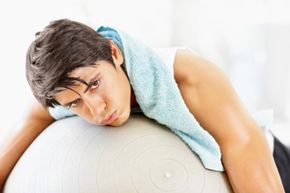Workout warm-ups help your body get ready for the intensity of your impending aerobic exercise. A good warm-up will help prepare your body. It will get your muscles, tendons and ligaments ready for the physical stress to come; it will stimulate the nervous system; it will increase your blood circulation and the amount of oxygen in your bloodstream; it will increase your heart rate; and it will gradually increase your core body temperature.
Increasing your core temperature also helps to increase your basal metabolic rate (BMR). Your BMR is how many calories your body needs to sustain itself while you're doing nothing at all, and the higher it is, the more calories you burn. Increase your core body temperature by 1 degree F (0.5 degree C) and you increase your basal metabolic rate by roughly 7 percent [source: ShapeFit]. Additionally, warm-up routines are important because your body is more flexible when you're warm. And being more flexible minimizes your risk of injuries such as strained muscles or torn ligaments. Warmed muscles also contract and relax faster to give you a more powerful performance and reduce how quickly you tire out.
Advertisement
Warm-ups should last about five to 10 minutes and should include stretching, walking, jogging or jumping rope, calisthenics -- and a shower? Maybe.
A hot shower at the beginning of your warm-up routine may help to raise your body temperature, and that may help you stretch and lengthen your muscles as you warm up for an intense workout. While a warm shower may help loosen you up, a cold shower before a workout generally is not on everyone's to-do list. Here's the scoop, though: The hotter your temperature is when you begin working out, the faster you'll burn out. Summer temperatures or intense workouts in hot environments increase your chance for heat stroke. This is where the idea of pre-cooling becomes important.
Advertisement

